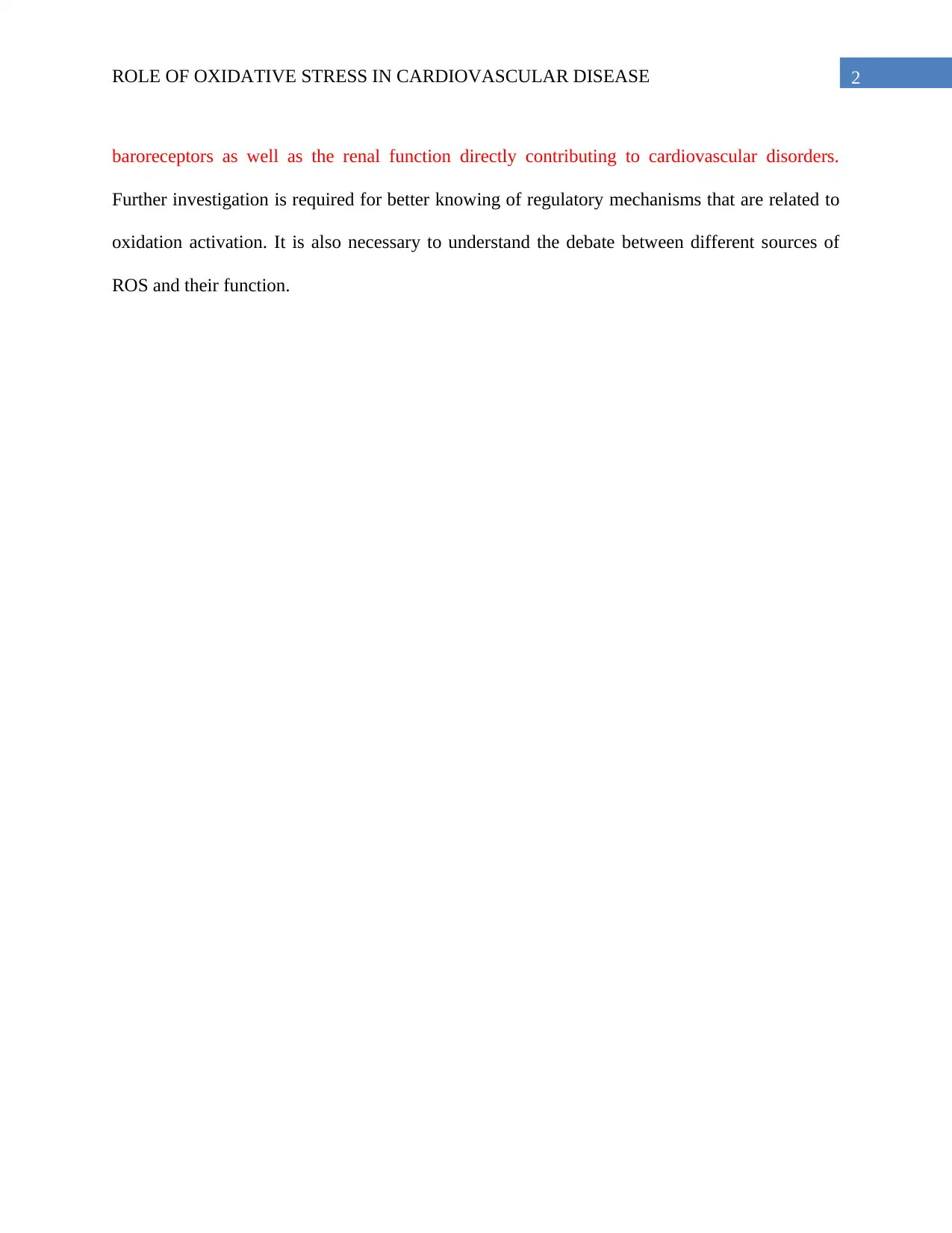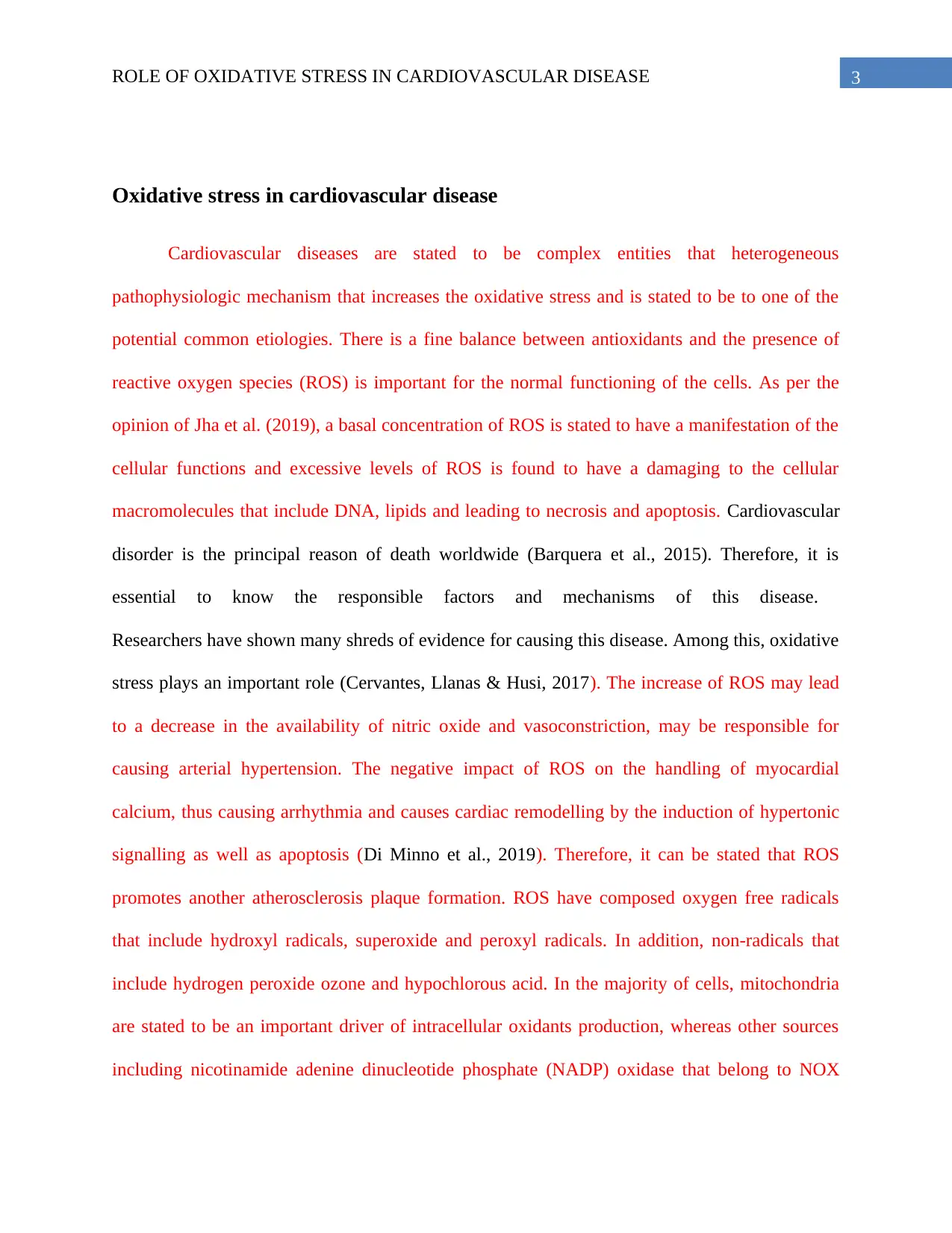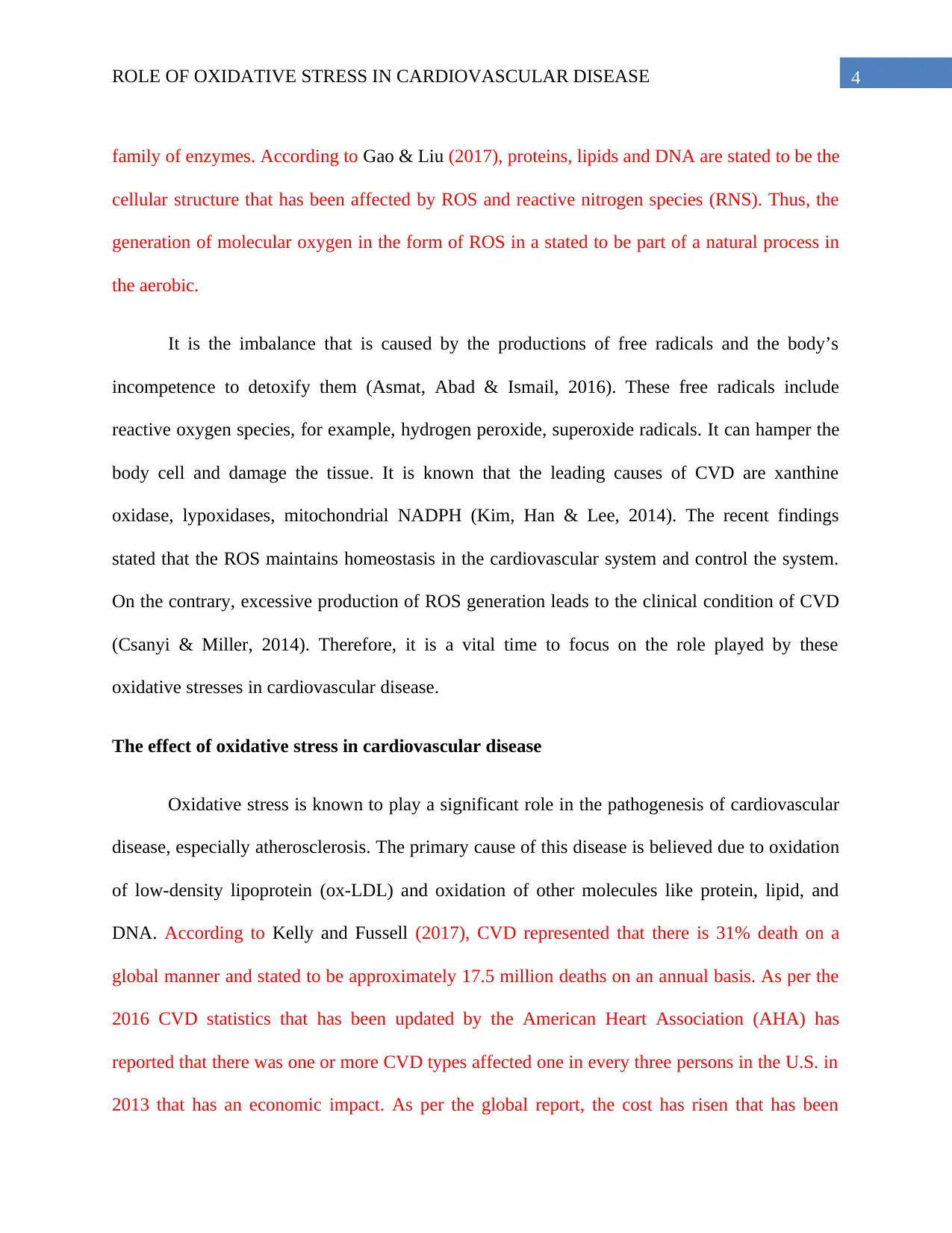University Study: Oxidative Stress's Role in Cardiovascular Disease
VerifiedAdded on 2022/08/26
|24
|6933
|21
Report
AI Summary
This report provides a comprehensive overview of the role of oxidative stress in cardiovascular disease (CVD). It examines the impact of reactive oxygen species (ROS), oxidized low-density lipoprotein (ox-LDL), and myeloperoxidase (MPO) in the development and progression of CVD, including atherosclerosis, heart failure, and other related conditions. The report discusses the mechanisms by which oxidative stress contributes to endothelial dysfunction, vascular remodeling, and inflammation. It also explores the role of NADPH oxidase and the imbalance between antioxidants and ROS production. The report highlights the importance of understanding the complex interplay of various factors in the pathogenesis of CVD. The report also includes discussion on the role of MPO and the generation of non-functioning lipoprotein that has been the potential of atherogenecity. The report concludes by emphasizing the need for further research to clarify the regulatory mechanisms related to oxidation activation and the debate between different sources of ROS and their function. The report also mentions the factors that are considered to play a vital role in the development of CVD that includes obesity, genetic predisposition, family history, diabetes, unhealthy and inactive lifestyle, tobacco smoking and oxidation stress.

Running head: ROLE OF OXIDATIVE STRESS IN CARDIOVASCULAR DISEASE
ROLE OF OXIDATIVE STRESS IN CARDIOVASCULAR DISEASE
Name of the Student
Name of the University
Author Note
ROLE OF OXIDATIVE STRESS IN CARDIOVASCULAR DISEASE
Name of the Student
Name of the University
Author Note
Paraphrase This Document
Need a fresh take? Get an instant paraphrase of this document with our AI Paraphraser

1ROLE OF OXIDATIVE STRESS IN CARDIOVASCULAR DISEASE
Abstract
Cardiovascular disease is a primary cause of death worldwide. Various mechanisms are related
to the causing of cardiovascular disease (CVD). Among these, the oxidative stress is novel.
Ongoing research is providing unique and innovative aspects for a better consideration of this
disease. Reactive oxygen species (ROS) are predominant in regulating cardiovascular diseases.
The role of different ROS species and how they are involved in the development of CVD are
addressed. Despite extensive research in this field, it is still unclear of many mechanisms related
to oxidative stress that is causing this disease. The function of oxidized Low-Density Lipoprotein
to varying stages of this disease is indistinct. From various reviews, it was understood that
oxidative stress in the cardiac and vascular mypocytes are described to be an injury that is caused
to the cells due to increase in formation of ROS and decrease in the antioxidant reversal process.
The increase in production of ROS in the body results in impairment or damage to the
mitochondrial reduction of molecular oxygen and thus, ROS is secreted by the WBCs causes’
endothelial dsyfunctioning and exposure to various risk factors that increase the risk or
prevalence of cardiovascular diseases. Thus, it can be stated that there is a close relationship
between oxidative stress and cardiovascular disease. From the study, it can be concluded that one
of the vital outcome of the activation of AngII type 1 receptors is the increase NADPH oxidase
activity that producing ROS specifically the super oxide anion. The organ that is targeted by Ang
II is brain in most cases by causing oxidative stress. In addition to this, the action of ROS in the
central nervous system is stated to be a critical mechanism that can lead to sympathetic
activation to failure of heart and hypertension. The increase in oxidative stress impair the
Abstract
Cardiovascular disease is a primary cause of death worldwide. Various mechanisms are related
to the causing of cardiovascular disease (CVD). Among these, the oxidative stress is novel.
Ongoing research is providing unique and innovative aspects for a better consideration of this
disease. Reactive oxygen species (ROS) are predominant in regulating cardiovascular diseases.
The role of different ROS species and how they are involved in the development of CVD are
addressed. Despite extensive research in this field, it is still unclear of many mechanisms related
to oxidative stress that is causing this disease. The function of oxidized Low-Density Lipoprotein
to varying stages of this disease is indistinct. From various reviews, it was understood that
oxidative stress in the cardiac and vascular mypocytes are described to be an injury that is caused
to the cells due to increase in formation of ROS and decrease in the antioxidant reversal process.
The increase in production of ROS in the body results in impairment or damage to the
mitochondrial reduction of molecular oxygen and thus, ROS is secreted by the WBCs causes’
endothelial dsyfunctioning and exposure to various risk factors that increase the risk or
prevalence of cardiovascular diseases. Thus, it can be stated that there is a close relationship
between oxidative stress and cardiovascular disease. From the study, it can be concluded that one
of the vital outcome of the activation of AngII type 1 receptors is the increase NADPH oxidase
activity that producing ROS specifically the super oxide anion. The organ that is targeted by Ang
II is brain in most cases by causing oxidative stress. In addition to this, the action of ROS in the
central nervous system is stated to be a critical mechanism that can lead to sympathetic
activation to failure of heart and hypertension. The increase in oxidative stress impair the

2ROLE OF OXIDATIVE STRESS IN CARDIOVASCULAR DISEASE
baroreceptors as well as the renal function directly contributing to cardiovascular disorders.
Further investigation is required for better knowing of regulatory mechanisms that are related to
oxidation activation. It is also necessary to understand the debate between different sources of
ROS and their function.
baroreceptors as well as the renal function directly contributing to cardiovascular disorders.
Further investigation is required for better knowing of regulatory mechanisms that are related to
oxidation activation. It is also necessary to understand the debate between different sources of
ROS and their function.
⊘ This is a preview!⊘
Do you want full access?
Subscribe today to unlock all pages.

Trusted by 1+ million students worldwide

3ROLE OF OXIDATIVE STRESS IN CARDIOVASCULAR DISEASE
Oxidative stress in cardiovascular disease
Cardiovascular diseases are stated to be complex entities that heterogeneous
pathophysiologic mechanism that increases the oxidative stress and is stated to be to one of the
potential common etiologies. There is a fine balance between antioxidants and the presence of
reactive oxygen species (ROS) is important for the normal functioning of the cells. As per the
opinion of Jha et al. (2019), a basal concentration of ROS is stated to have a manifestation of the
cellular functions and excessive levels of ROS is found to have a damaging to the cellular
macromolecules that include DNA, lipids and leading to necrosis and apoptosis. Cardiovascular
disorder is the principal reason of death worldwide (Barquera et al., 2015). Therefore, it is
essential to know the responsible factors and mechanisms of this disease.
Researchers have shown many shreds of evidence for causing this disease. Among this, oxidative
stress plays an important role (Cervantes, Llanas & Husi, 2017). The increase of ROS may lead
to a decrease in the availability of nitric oxide and vasoconstriction, may be responsible for
causing arterial hypertension. The negative impact of ROS on the handling of myocardial
calcium, thus causing arrhythmia and causes cardiac remodelling by the induction of hypertonic
signalling as well as apoptosis (Di Minno et al., 2019). Therefore, it can be stated that ROS
promotes another atherosclerosis plaque formation. ROS have composed oxygen free radicals
that include hydroxyl radicals, superoxide and peroxyl radicals. In addition, non-radicals that
include hydrogen peroxide ozone and hypochlorous acid. In the majority of cells, mitochondria
are stated to be an important driver of intracellular oxidants production, whereas other sources
including nicotinamide adenine dinucleotide phosphate (NADP) oxidase that belong to NOX
Oxidative stress in cardiovascular disease
Cardiovascular diseases are stated to be complex entities that heterogeneous
pathophysiologic mechanism that increases the oxidative stress and is stated to be to one of the
potential common etiologies. There is a fine balance between antioxidants and the presence of
reactive oxygen species (ROS) is important for the normal functioning of the cells. As per the
opinion of Jha et al. (2019), a basal concentration of ROS is stated to have a manifestation of the
cellular functions and excessive levels of ROS is found to have a damaging to the cellular
macromolecules that include DNA, lipids and leading to necrosis and apoptosis. Cardiovascular
disorder is the principal reason of death worldwide (Barquera et al., 2015). Therefore, it is
essential to know the responsible factors and mechanisms of this disease.
Researchers have shown many shreds of evidence for causing this disease. Among this, oxidative
stress plays an important role (Cervantes, Llanas & Husi, 2017). The increase of ROS may lead
to a decrease in the availability of nitric oxide and vasoconstriction, may be responsible for
causing arterial hypertension. The negative impact of ROS on the handling of myocardial
calcium, thus causing arrhythmia and causes cardiac remodelling by the induction of hypertonic
signalling as well as apoptosis (Di Minno et al., 2019). Therefore, it can be stated that ROS
promotes another atherosclerosis plaque formation. ROS have composed oxygen free radicals
that include hydroxyl radicals, superoxide and peroxyl radicals. In addition, non-radicals that
include hydrogen peroxide ozone and hypochlorous acid. In the majority of cells, mitochondria
are stated to be an important driver of intracellular oxidants production, whereas other sources
including nicotinamide adenine dinucleotide phosphate (NADP) oxidase that belong to NOX
Paraphrase This Document
Need a fresh take? Get an instant paraphrase of this document with our AI Paraphraser

4ROLE OF OXIDATIVE STRESS IN CARDIOVASCULAR DISEASE
family of enzymes. According to Gao & Liu (2017), proteins, lipids and DNA are stated to be the
cellular structure that has been affected by ROS and reactive nitrogen species (RNS). Thus, the
generation of molecular oxygen in the form of ROS in a stated to be part of a natural process in
the aerobic.
It is the imbalance that is caused by the productions of free radicals and the body’s
incompetence to detoxify them (Asmat, Abad & Ismail, 2016). These free radicals include
reactive oxygen species, for example, hydrogen peroxide, superoxide radicals. It can hamper the
body cell and damage the tissue. It is known that the leading causes of CVD are xanthine
oxidase, lypoxidases, mitochondrial NADPH (Kim, Han & Lee, 2014). The recent findings
stated that the ROS maintains homeostasis in the cardiovascular system and control the system.
On the contrary, excessive production of ROS generation leads to the clinical condition of CVD
(Csanyi & Miller, 2014). Therefore, it is a vital time to focus on the role played by these
oxidative stresses in cardiovascular disease.
The effect of oxidative stress in cardiovascular disease
Oxidative stress is known to play a significant role in the pathogenesis of cardiovascular
disease, especially atherosclerosis. The primary cause of this disease is believed due to oxidation
of low-density lipoprotein (ox-LDL) and oxidation of other molecules like protein, lipid, and
DNA. According to Kelly and Fussell (2017), CVD represented that there is 31% death on a
global manner and stated to be approximately 17.5 million deaths on an annual basis. As per the
2016 CVD statistics that has been updated by the American Heart Association (AHA) has
reported that there was one or more CVD types affected one in every three persons in the U.S. in
2013 that has an economic impact. As per the global report, the cost has risen that has been
family of enzymes. According to Gao & Liu (2017), proteins, lipids and DNA are stated to be the
cellular structure that has been affected by ROS and reactive nitrogen species (RNS). Thus, the
generation of molecular oxygen in the form of ROS in a stated to be part of a natural process in
the aerobic.
It is the imbalance that is caused by the productions of free radicals and the body’s
incompetence to detoxify them (Asmat, Abad & Ismail, 2016). These free radicals include
reactive oxygen species, for example, hydrogen peroxide, superoxide radicals. It can hamper the
body cell and damage the tissue. It is known that the leading causes of CVD are xanthine
oxidase, lypoxidases, mitochondrial NADPH (Kim, Han & Lee, 2014). The recent findings
stated that the ROS maintains homeostasis in the cardiovascular system and control the system.
On the contrary, excessive production of ROS generation leads to the clinical condition of CVD
(Csanyi & Miller, 2014). Therefore, it is a vital time to focus on the role played by these
oxidative stresses in cardiovascular disease.
The effect of oxidative stress in cardiovascular disease
Oxidative stress is known to play a significant role in the pathogenesis of cardiovascular
disease, especially atherosclerosis. The primary cause of this disease is believed due to oxidation
of low-density lipoprotein (ox-LDL) and oxidation of other molecules like protein, lipid, and
DNA. According to Kelly and Fussell (2017), CVD represented that there is 31% death on a
global manner and stated to be approximately 17.5 million deaths on an annual basis. As per the
2016 CVD statistics that has been updated by the American Heart Association (AHA) has
reported that there was one or more CVD types affected one in every three persons in the U.S. in
2013 that has an economic impact. As per the global report, the cost has risen that has been

5ROLE OF OXIDATIVE STRESS IN CARDIOVASCULAR DISEASE
estimated to be $863 billion in 2010 and it has been expected to increase to $1044 billion by the
end of 2030 (Pignatelli et al., 2018). The damage of CVD involves remodelling of the blood
vessels resulted in the blood flow restrictions and affected the heart and nervous system. The
disorders that are comprised CVD includes coronary artery, stroke, congenital heart disease,
heart failure, hypertension, rheumatoid aetiologies and peripheral vascular diseases. According
to Park et al. (2017), in the year 2011, the AHA has introduced preeclampsia (PE) as one of the
risk factors of CVD. From the broad spectrum of CVD, there are a number of well-known factors
that are considered to play a vital role in the development of CVD that includes obesity, genetic
predisposition, family history, diabetes, unhealthy and inactive lifestyle, tobacco smoking and
oxidation stress. Del Buono et al. (2018) opined that aging is a common risk factor that is stated
to be non-modifiable as the impact of the increase in age increase the prevalence of the disease
because of the fact that it leads to accumulation of oxidative damage over the years in a human.
Cardiovascular disease and the Ox-LDL
The ox-LDL has an essential role in plaque formation and development in atherosclerosis
(Chaabane, Coen & Bochaton-Piallat, 2014). The purpose of ox-LDL in the event of CVD is
mediated by two mechanisms. One is the immunologic response to ox-LDL, and the other is
murine monoclonal antibodies, which relate to various epitopes on the ox-LDL molecule. The
immunogenic reaction in ox-LDL is based on copper oxidized LDL or malondialdehyde-LDL
(MDA-LDL) (Strobel et al., 2011). The first experiment used two different markers and showed
different results based on the marker. The study found that the use of the ox-LDL marker was
predictive of whether the copper oxidized was not. At the time of inflammation, the synthesis of
a number of different cells types occurs that secrete phosphokinase A2, which help in catalysing
estimated to be $863 billion in 2010 and it has been expected to increase to $1044 billion by the
end of 2030 (Pignatelli et al., 2018). The damage of CVD involves remodelling of the blood
vessels resulted in the blood flow restrictions and affected the heart and nervous system. The
disorders that are comprised CVD includes coronary artery, stroke, congenital heart disease,
heart failure, hypertension, rheumatoid aetiologies and peripheral vascular diseases. According
to Park et al. (2017), in the year 2011, the AHA has introduced preeclampsia (PE) as one of the
risk factors of CVD. From the broad spectrum of CVD, there are a number of well-known factors
that are considered to play a vital role in the development of CVD that includes obesity, genetic
predisposition, family history, diabetes, unhealthy and inactive lifestyle, tobacco smoking and
oxidation stress. Del Buono et al. (2018) opined that aging is a common risk factor that is stated
to be non-modifiable as the impact of the increase in age increase the prevalence of the disease
because of the fact that it leads to accumulation of oxidative damage over the years in a human.
Cardiovascular disease and the Ox-LDL
The ox-LDL has an essential role in plaque formation and development in atherosclerosis
(Chaabane, Coen & Bochaton-Piallat, 2014). The purpose of ox-LDL in the event of CVD is
mediated by two mechanisms. One is the immunologic response to ox-LDL, and the other is
murine monoclonal antibodies, which relate to various epitopes on the ox-LDL molecule. The
immunogenic reaction in ox-LDL is based on copper oxidized LDL or malondialdehyde-LDL
(MDA-LDL) (Strobel et al., 2011). The first experiment used two different markers and showed
different results based on the marker. The study found that the use of the ox-LDL marker was
predictive of whether the copper oxidized was not. At the time of inflammation, the synthesis of
a number of different cells types occurs that secrete phosphokinase A2, which help in catalysing
⊘ This is a preview!⊘
Do you want full access?
Subscribe today to unlock all pages.

Trusted by 1+ million students worldwide

6ROLE OF OXIDATIVE STRESS IN CARDIOVASCULAR DISEASE
the process of lipid oxidation in LDL (Gao et al., 2017). A heme protein known as
Myeloperoxidase is being secreted by the activated phagocytes that help in oxidizing L-tyrosine
into a compound known as tyrosyl radical. This compound is stated to be a physiological catalyst
that supports the process of initiation in lipid oxidation of LDL. As per the opinion of Wang et
al, (2019), lipid oxidation involves the generation of aldehydes which are the substitute of lysine
residues in the moiety of apolipoprotein B-100. The lipids in collaboration with the protein help
in generation of oxidized LDL in the body. As per the study conducted by Gao and Liu (2017),
there is an association between coronary heart disease (CHD) and the increase in the plasma
level of the oxidized LDL. As per the recent demonstration, it was found that there is a
prevalence of elevated oxidized LDL among people that has a high risk of CHD. The likely
reason for this is the CDH has been diagnosed patients that are being treated with statin who
have appeared to have a decrease in oxidized LDL due to the cholesterol-lowering effects.
Myeloperoxidase (MPO) and cardiovascular disease
Myeloperoxidase (MPO) is stated to be a member of a superfamily of heme peroxidase
that are mainly expressed in the monocytes and neutrophils. The MPO derived reactive species
are playing an important in the neutrophil antimicrobial activity and in the defence against
various pathogens in participating in the process of phagocytosis. The high level of MPO in the
blood circulation is associated to the symptoms such as inflammation and increase in oxidative
stress. As per the opinion of Oyenuga et al. (2018), a multiple lines of evidence have suggested
that there is association between cardiovascular disease and MPO that include congestive heart
failure, coronary heart disease, arterial hypertension, stroke, peripheral arterial diseases, venous
thrombosis and others. The increase in the level of MO is linked with poor prognosis and thus,
the process of lipid oxidation in LDL (Gao et al., 2017). A heme protein known as
Myeloperoxidase is being secreted by the activated phagocytes that help in oxidizing L-tyrosine
into a compound known as tyrosyl radical. This compound is stated to be a physiological catalyst
that supports the process of initiation in lipid oxidation of LDL. As per the opinion of Wang et
al, (2019), lipid oxidation involves the generation of aldehydes which are the substitute of lysine
residues in the moiety of apolipoprotein B-100. The lipids in collaboration with the protein help
in generation of oxidized LDL in the body. As per the study conducted by Gao and Liu (2017),
there is an association between coronary heart disease (CHD) and the increase in the plasma
level of the oxidized LDL. As per the recent demonstration, it was found that there is a
prevalence of elevated oxidized LDL among people that has a high risk of CHD. The likely
reason for this is the CDH has been diagnosed patients that are being treated with statin who
have appeared to have a decrease in oxidized LDL due to the cholesterol-lowering effects.
Myeloperoxidase (MPO) and cardiovascular disease
Myeloperoxidase (MPO) is stated to be a member of a superfamily of heme peroxidase
that are mainly expressed in the monocytes and neutrophils. The MPO derived reactive species
are playing an important in the neutrophil antimicrobial activity and in the defence against
various pathogens in participating in the process of phagocytosis. The high level of MPO in the
blood circulation is associated to the symptoms such as inflammation and increase in oxidative
stress. As per the opinion of Oyenuga et al. (2018), a multiple lines of evidence have suggested
that there is association between cardiovascular disease and MPO that include congestive heart
failure, coronary heart disease, arterial hypertension, stroke, peripheral arterial diseases, venous
thrombosis and others. The increase in the level of MO is linked with poor prognosis and thus,
Paraphrase This Document
Need a fresh take? Get an instant paraphrase of this document with our AI Paraphraser

7ROLE OF OXIDATIVE STRESS IN CARDIOVASCULAR DISEASE
increase the risk of CVD for two particular reasons. The first reason is due to the low-grade
inflammation and the increase in oxidative stress that cohabit in cases of various metabolic
abnormalities and the high level of MPO has been representing an increase in cardio metabolic
risk on a general term. In addition, Khalilova et al. (2018) opined that another reason was the
production of large number of highly reactive species by MPO that can attack, affect and even
destroy the function at the cellular level. Many studies exhibited that MPO is responsible for
causing CVD (Violi & Pignatelli, 2015). MPO showed an elevated risk of myocardial infarction
(MI), major adverse coronary outcomes, and revascularization. Moreover, MPO is accountable
for causing chronic systolic heart failures, asymptomatic coronary heart disease in people. The
event of neutrophil activation stimulation occurs due to vasospasm or thrombosis that is
responsible for creating CVD (Wang et al., 2017). Though there is enough evidence regarding
the association of ox-LDL with CVD, the issue is unclear. Nonetheless, MPO exhibits promising
factor as an oxidative stress biomarker (Anatoliotakis et al., 2013). It can be stated that the most
common MPO action that is in conjunction with CVD are the generation of non-functioning
lipoprotein that has been the potential of atherogenecity, NO availability was less,
dysfunctioning of endothelium, vasoreactivity is impaired and instability in the atherosclerosis
plaque. The impairment or dysfucntioning suggest that there is a direct impact of MPO on the
pathophysiology of CVD. It acts a mediator that promotes inflammation among the CV patients
at cellular and molecular level (Mirmohammadsadeghi et al., 2018). Further research is needed
to know the role of oxidative stress in cardiovascular disease.
The NADPH oxidase
increase the risk of CVD for two particular reasons. The first reason is due to the low-grade
inflammation and the increase in oxidative stress that cohabit in cases of various metabolic
abnormalities and the high level of MPO has been representing an increase in cardio metabolic
risk on a general term. In addition, Khalilova et al. (2018) opined that another reason was the
production of large number of highly reactive species by MPO that can attack, affect and even
destroy the function at the cellular level. Many studies exhibited that MPO is responsible for
causing CVD (Violi & Pignatelli, 2015). MPO showed an elevated risk of myocardial infarction
(MI), major adverse coronary outcomes, and revascularization. Moreover, MPO is accountable
for causing chronic systolic heart failures, asymptomatic coronary heart disease in people. The
event of neutrophil activation stimulation occurs due to vasospasm or thrombosis that is
responsible for creating CVD (Wang et al., 2017). Though there is enough evidence regarding
the association of ox-LDL with CVD, the issue is unclear. Nonetheless, MPO exhibits promising
factor as an oxidative stress biomarker (Anatoliotakis et al., 2013). It can be stated that the most
common MPO action that is in conjunction with CVD are the generation of non-functioning
lipoprotein that has been the potential of atherogenecity, NO availability was less,
dysfunctioning of endothelium, vasoreactivity is impaired and instability in the atherosclerosis
plaque. The impairment or dysfucntioning suggest that there is a direct impact of MPO on the
pathophysiology of CVD. It acts a mediator that promotes inflammation among the CV patients
at cellular and molecular level (Mirmohammadsadeghi et al., 2018). Further research is needed
to know the role of oxidative stress in cardiovascular disease.
The NADPH oxidase

8ROLE OF OXIDATIVE STRESS IN CARDIOVASCULAR DISEASE
The NOX is under the family of NADPH oxidase. It is the trans-membrane protein that
transfers a single electron from NADPH into molecular oxygen and forms superoxide (Tarafdar
& Pula, 2018). The NOX generated ROS is identified as oxidative burst and stimulates the
removal of microorganisms in neutrophil and macrophage. The first invented NADPH oxidase,
NOX, was found in phagocytes. These NOX enzymes are accountable for the pathogenesis of
several CVD (Brown & Griendling, 2015). From the opinion of Orr and Woolard (2019), it was
known that ROS contributes to a number of aspects in the vascular diseases that include
ischemia-reperfusion injury, stimulation of inflammatory behaviour, scavenging of nitric oxide
and hypertrophy. The NADPH oxidase are found to expressed in a different manner in
development of CVD that either induce or activates the risk factors associated with the
conditions and thus, is responsible for contributing to the oxidative burden of such disorders. In
addition to this, Ritchie et al. (2017) opined that NADPH oxidase-derived ROS are stated to be
an important signalling molecule under some of the physiological conditions. Another study
opined by Touyz et al. (2019) had similar viewpoint, which stated that the activation of NADHP
oxidase (NOX) has a vital role in pathogenesis of cardiovascular disease. This is because it
induces the activation process of the downstream secondary oxidase systems that include
xanthine oxidase, endothelial nitric oxide synthase and dysfunctional mitochondria. The cross
talks that is occurring in relation to oxidases and oxidase system are useful in sustaining the
oxidative stress which ultimately lead to development of the diseases. Zhang et al. (2019) opined
that using targeting NOXs and the interaction of NOXs and secondary oxidase system can be
beneficial and can be used a unique therapeutic strategy that help in prevention as well as
treatment of CVD.
The NOX is under the family of NADPH oxidase. It is the trans-membrane protein that
transfers a single electron from NADPH into molecular oxygen and forms superoxide (Tarafdar
& Pula, 2018). The NOX generated ROS is identified as oxidative burst and stimulates the
removal of microorganisms in neutrophil and macrophage. The first invented NADPH oxidase,
NOX, was found in phagocytes. These NOX enzymes are accountable for the pathogenesis of
several CVD (Brown & Griendling, 2015). From the opinion of Orr and Woolard (2019), it was
known that ROS contributes to a number of aspects in the vascular diseases that include
ischemia-reperfusion injury, stimulation of inflammatory behaviour, scavenging of nitric oxide
and hypertrophy. The NADPH oxidase are found to expressed in a different manner in
development of CVD that either induce or activates the risk factors associated with the
conditions and thus, is responsible for contributing to the oxidative burden of such disorders. In
addition to this, Ritchie et al. (2017) opined that NADPH oxidase-derived ROS are stated to be
an important signalling molecule under some of the physiological conditions. Another study
opined by Touyz et al. (2019) had similar viewpoint, which stated that the activation of NADHP
oxidase (NOX) has a vital role in pathogenesis of cardiovascular disease. This is because it
induces the activation process of the downstream secondary oxidase systems that include
xanthine oxidase, endothelial nitric oxide synthase and dysfunctional mitochondria. The cross
talks that is occurring in relation to oxidases and oxidase system are useful in sustaining the
oxidative stress which ultimately lead to development of the diseases. Zhang et al. (2019) opined
that using targeting NOXs and the interaction of NOXs and secondary oxidase system can be
beneficial and can be used a unique therapeutic strategy that help in prevention as well as
treatment of CVD.
⊘ This is a preview!⊘
Do you want full access?
Subscribe today to unlock all pages.

Trusted by 1+ million students worldwide

9ROLE OF OXIDATIVE STRESS IN CARDIOVASCULAR DISEASE
NOX in Atherosclerosis
NOX-2 is an isoform of NADPH oxidase that leads to the cause of atherogenesis
(Konikar et al., 2014). It is seen that endothelial cells prompt four types of NOX isoforms
besides superoxide enzymes like NOX2, NOX1, NOX5, and hydrogen peroxide enzyme-like
NOX4. Studies showed that NOX2, NOX1, and NOX5 are engaged in endothelial dysfunction,
apoptosis, and inflammation, while the NOX4 is vasoprotective in nature and enhances nitric
oxide bioavailability as well as inhibits cell death pathways (Drummond & Sobey, 2014).
Many studies revealed that oxidative stress and reactive oxygen species (ROS) are
accompanied with aging and disease, such as atherosclerosis, diabetes, and arterial fibrillation
(Liguori et al., 2018). Among these, NADPH oxidases (NOX) are a vital source of ROS and
facilitate redox signalling under pathophysiological and physical condition. The NOX-mediated
ROS signalling pathway is associated with age-related cardiovascular disease. In the aging
process, the study reported that the up-regulated activity of NOX is connected with age-related
increased blood pressure, cardiac fibrosis, coronary artery remodelling. The NOX dependent
ROS is linked with elevated renin-angiotensin-aldosterone (RAAS) activation, stimulation of
matrix-metalloproteinase -2(MMP-2), up-regulated expression of connective tissue growth factor
and tumour growth factor β1 that increased the risk of cardiac remodelling in aged people.
The NADPH oxidase derived superoxide increases the chance of atherosclerosis. Based
on clinical experiments, NADPH oxidase is proved to be the critical source of the production of
superoxide in human saphenous veins. It is interconnected with decreased NO-mediated
endothelial function and increases atherosclerosis threat in the aged-person (Meza et al., 2019).
Other studies detected that p22 and NOX 2, NOX4 were highly expressed in the shoulder area of
NOX in Atherosclerosis
NOX-2 is an isoform of NADPH oxidase that leads to the cause of atherogenesis
(Konikar et al., 2014). It is seen that endothelial cells prompt four types of NOX isoforms
besides superoxide enzymes like NOX2, NOX1, NOX5, and hydrogen peroxide enzyme-like
NOX4. Studies showed that NOX2, NOX1, and NOX5 are engaged in endothelial dysfunction,
apoptosis, and inflammation, while the NOX4 is vasoprotective in nature and enhances nitric
oxide bioavailability as well as inhibits cell death pathways (Drummond & Sobey, 2014).
Many studies revealed that oxidative stress and reactive oxygen species (ROS) are
accompanied with aging and disease, such as atherosclerosis, diabetes, and arterial fibrillation
(Liguori et al., 2018). Among these, NADPH oxidases (NOX) are a vital source of ROS and
facilitate redox signalling under pathophysiological and physical condition. The NOX-mediated
ROS signalling pathway is associated with age-related cardiovascular disease. In the aging
process, the study reported that the up-regulated activity of NOX is connected with age-related
increased blood pressure, cardiac fibrosis, coronary artery remodelling. The NOX dependent
ROS is linked with elevated renin-angiotensin-aldosterone (RAAS) activation, stimulation of
matrix-metalloproteinase -2(MMP-2), up-regulated expression of connective tissue growth factor
and tumour growth factor β1 that increased the risk of cardiac remodelling in aged people.
The NADPH oxidase derived superoxide increases the chance of atherosclerosis. Based
on clinical experiments, NADPH oxidase is proved to be the critical source of the production of
superoxide in human saphenous veins. It is interconnected with decreased NO-mediated
endothelial function and increases atherosclerosis threat in the aged-person (Meza et al., 2019).
Other studies detected that p22 and NOX 2, NOX4 were highly expressed in the shoulder area of
Paraphrase This Document
Need a fresh take? Get an instant paraphrase of this document with our AI Paraphraser

10ROLE OF OXIDATIVE STRESS IN CARDIOVASCULAR DISEASE
plaque in an atherosclerotic patient, whereas the NOX1 expression was reduced (Sahoo, Meijles,
& Pagano, 2016).
Role of NOX1 in CVD
At the time of examining the coronary arteries, the study demonstrated that the NOX1
and ROS levels are elevated in the lesion area compared to non-complicated plaque. This study
has led to the advancement of new research, where it showed that both NOXO1 and NOXA1
showed increased expression in carotid lesions. Further investigation has supported this evidence
in atherosclerosis (Fulton & Barman, 2016). It was found that NOX1 levels are grown in the
early development of lesion in the aorta, while NOX2 is elevated throughout the disease
development, and NOX4 is increased only in advanced lesions (Gimenez, Schickling, Lopes &
Miller, 2016). After the discovery of the molecules in 1999, there have being many studies that
had been conducted in order to evaluate the role of NOX1 NADPH oxidase in the cardiovascular
system. As per the opinion of Touyz et al. (2019), NOX1 is found to be activated in the vascular
cells when there is a response from different agonists that is being actively regulated especially
at the transcription level. It can be seen that the molecule takes part in NADPH oxidase complex
formation, stabilisation of proteins and in the process of posttranscriptional modification. In
another study, it was found that NOX1 is responsible for decrease in the bioavailability of nitric
oxide and transactivation of the epidermal growth factor receptors, induction of pro-
inflammatory signalling and cell migration and proliferation. In one of the review, studies was
conducted on the genetic model of NOX1 overexpression or deficiency that revealed that there is
a role of this molecule in the pathogenesis of cardiovascular diseases that ranges from
hypertension to atherosclerosis and retenosis (Zhang et al., 2016). Thus, it can be suggested that
plaque in an atherosclerotic patient, whereas the NOX1 expression was reduced (Sahoo, Meijles,
& Pagano, 2016).
Role of NOX1 in CVD
At the time of examining the coronary arteries, the study demonstrated that the NOX1
and ROS levels are elevated in the lesion area compared to non-complicated plaque. This study
has led to the advancement of new research, where it showed that both NOXO1 and NOXA1
showed increased expression in carotid lesions. Further investigation has supported this evidence
in atherosclerosis (Fulton & Barman, 2016). It was found that NOX1 levels are grown in the
early development of lesion in the aorta, while NOX2 is elevated throughout the disease
development, and NOX4 is increased only in advanced lesions (Gimenez, Schickling, Lopes &
Miller, 2016). After the discovery of the molecules in 1999, there have being many studies that
had been conducted in order to evaluate the role of NOX1 NADPH oxidase in the cardiovascular
system. As per the opinion of Touyz et al. (2019), NOX1 is found to be activated in the vascular
cells when there is a response from different agonists that is being actively regulated especially
at the transcription level. It can be seen that the molecule takes part in NADPH oxidase complex
formation, stabilisation of proteins and in the process of posttranscriptional modification. In
another study, it was found that NOX1 is responsible for decrease in the bioavailability of nitric
oxide and transactivation of the epidermal growth factor receptors, induction of pro-
inflammatory signalling and cell migration and proliferation. In one of the review, studies was
conducted on the genetic model of NOX1 overexpression or deficiency that revealed that there is
a role of this molecule in the pathogenesis of cardiovascular diseases that ranges from
hypertension to atherosclerosis and retenosis (Zhang et al., 2016). Thus, it can be suggested that

11ROLE OF OXIDATIVE STRESS IN CARDIOVASCULAR DISEASE
NOX1 can be used as a potential target in the vascular disease as well as in drug development,
which is an ongoing g process for identification of specific bioavailable inhibitor of NOX1.
Atherosclerosis and oxidative stress
Researchers found that Oxidative stress is involved in causing atherosclerosis. It is
demonstrated that chronic inflammation followed by oxidative stress is accompanied by this
disorder. The study has revealed that the ROS production initiates atherosclerosis by three
mechanisms. The oxidized-LDL develops atherosclerosis by forming the foam cells. It also
stimulates monocytes differentiation and triggers metalloproteinase.
Along with this, it induces the proatherogenic genes such as COX, e-NOS, and PDGF (Linton et
al., 2019). Hydrogen peroxide, a major ROS, is transformed from superoxide that has oxidative
damage and escapes from mitochondrial dysfunction. This mitochondrial dysfunction has
directed to the primary atherosclerotic lesion and other cardiovascular disorders (Volobueva et
al., 2019). The study has demonstrated that the ROS modifying enzyme-like NADPH oxidase
and MPO played a vital role in the advancement of cardiovascular disorder. The pro-oxidant
molecules like oxLDL and 8-iso-PGF are shown in chronic coronary artery disease patients
(Lara-Guzmán et al., 2018). The interconnection between ox-LDL and CAD has been identified.
There is also a relationship between MPO activity and CAD. NOX2 has an essential role in
causing the atherosclerotic process (Quesada et al., 2015). The NOX5 and NOX1 prompt in O2-
formation and proliferates human smooth muscle cells. The NOX4 promotes hydrogen peroxide
formation, which has vasodilation characteristics with the help of eNOS activation (Pignatelli et
al., 2018). It demonstrates that the interconnection between mitochondrial ROS and endothelial
malfunction (Li et al., 2016).
NOX1 can be used as a potential target in the vascular disease as well as in drug development,
which is an ongoing g process for identification of specific bioavailable inhibitor of NOX1.
Atherosclerosis and oxidative stress
Researchers found that Oxidative stress is involved in causing atherosclerosis. It is
demonstrated that chronic inflammation followed by oxidative stress is accompanied by this
disorder. The study has revealed that the ROS production initiates atherosclerosis by three
mechanisms. The oxidized-LDL develops atherosclerosis by forming the foam cells. It also
stimulates monocytes differentiation and triggers metalloproteinase.
Along with this, it induces the proatherogenic genes such as COX, e-NOS, and PDGF (Linton et
al., 2019). Hydrogen peroxide, a major ROS, is transformed from superoxide that has oxidative
damage and escapes from mitochondrial dysfunction. This mitochondrial dysfunction has
directed to the primary atherosclerotic lesion and other cardiovascular disorders (Volobueva et
al., 2019). The study has demonstrated that the ROS modifying enzyme-like NADPH oxidase
and MPO played a vital role in the advancement of cardiovascular disorder. The pro-oxidant
molecules like oxLDL and 8-iso-PGF are shown in chronic coronary artery disease patients
(Lara-Guzmán et al., 2018). The interconnection between ox-LDL and CAD has been identified.
There is also a relationship between MPO activity and CAD. NOX2 has an essential role in
causing the atherosclerotic process (Quesada et al., 2015). The NOX5 and NOX1 prompt in O2-
formation and proliferates human smooth muscle cells. The NOX4 promotes hydrogen peroxide
formation, which has vasodilation characteristics with the help of eNOS activation (Pignatelli et
al., 2018). It demonstrates that the interconnection between mitochondrial ROS and endothelial
malfunction (Li et al., 2016).
⊘ This is a preview!⊘
Do you want full access?
Subscribe today to unlock all pages.

Trusted by 1+ million students worldwide
1 out of 24
Related Documents
Your All-in-One AI-Powered Toolkit for Academic Success.
+13062052269
info@desklib.com
Available 24*7 on WhatsApp / Email
![[object Object]](/_next/static/media/star-bottom.7253800d.svg)
Unlock your academic potential
Copyright © 2020–2025 A2Z Services. All Rights Reserved. Developed and managed by ZUCOL.





